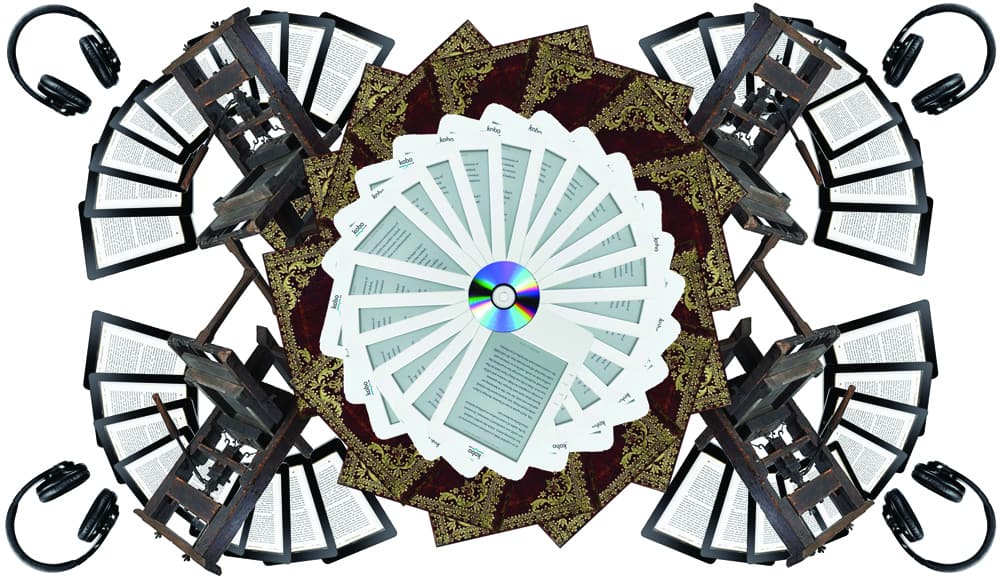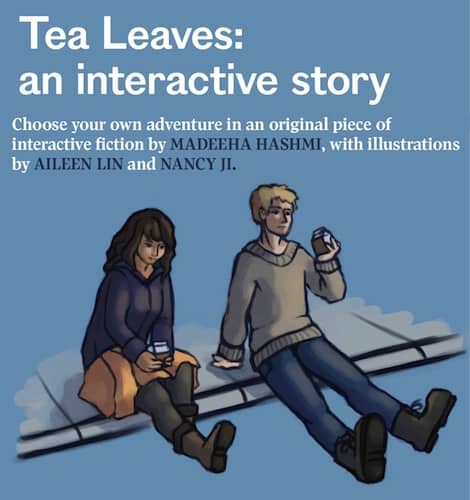It’s difficult to imagine that something as ubiquitous as the book could ever be in danger of becoming obsolete. The written word has been a subject of continued technological innovations—from clay tablets and papyrus scrolls, to monotype and linotype machinery during the Industrial Revolution.
Click the picture below to read Tea Leaves: an interactive story
While all of these steps towards the modern book seemed radical at the time, they all stayed true to one feature that seems integral to the book in its traditional conception: its physicality. The “Digital Revolution” has changed this central aspect of the book, which for so long was unquestioned and immutable.
Books no longer need to be heavy codices, with static story lines that are solely reliant on the reader’s imagination—new and creative formats are pushing these limits, and the field of publishing is bustling with new potential. In spite of this, these new possibilities are paired with warnings of the “death of print” and other losses in the publishing industry.
Unprecedented access
As university students today, we are the first generation to study literature in the digital age. Some students use e-books as cheaper alternatives to textbooks, and many prefer finding scholarly articles in an online database when doing research, instead of trudging up to the Robart’s stacks.
Reading online has become an inevitable part of daily life for many, but it represents a fundamental shift towards digitization that impacts the way students approach and understand texts.
University of Guelph Professor Adam Hammond, who taught “The Digital Text” at U of T in the fall 2013 semester, is well versed in how the digital world has changed the parameters of literature: “In the most basic sense, digitization lets people self-publish very, very easily. It has traditionally been very hard for writers to get in to print — to get their work to readers.”
Using digital publishing, writers can easily have their works published, and can exert control over much of the publishing process. In turn, readers have unprecedented access to a variety of free or inexpensive self-published works online.
“The upside is the massively increased access to the means of production. The downside is that it’s hard to be heard when so many voices are getting in to print.”
Technology and storytelling
Hammond’s class examined online interactive fiction as one of the new forms emerging from digital publishing. Interactive fiction allows the reader to choose the path the character within the story is going to take, leading to a different plot and outcome each time.
“While most print fiction is linear, many digital texts have massive numbers of possible pathways, and the reader actually gets to ‘co-author’ the work in a sense… The author still lays out all the possibilities in advance, and gets to decide where, and what, choices are possible”.
Hammond’s favourite example is Stephen Marche’s Lucy Hardin’s Missing Period, an interactive novel published by The Walrus in 2010.
“When you’re thinking in digital terms, it stops making sense to draw hard lines between literature and multimedia forms like movies, graphic novels, and video games. They’re all ‘narrative art forms’ — ways of telling stories… Video games are probably the ‘ultimate’ digital storytelling medium, since they combine narratives, words, images, sounds, music and interactivity, wrapped into one.”
The marriage of technology and literature allows for other mediums of storytelling to be incorporated into the reading experience. Digital literature breaks down the traditional barriers between media —combining words with images, videos, sounds, and music—to create an immersive experience.
From CD-ROMs to e-books
While developments in digital publishing have posed a challenge to the traditional print publishing industry, digitization does not necessarily point to the death of the printed word. Publishing houses have had to change their mandates in order to build digital and web presences. They have adapted their approaches to the changing market for the literature, which has produced exciting results.
One person affected by these changes was Cynthia Good. Good was president and publisher of Penguin Books for 20 years before working for The Walrus magazine and taking up a position at Humber College as director of the Creative Book Publishing program. The program prepares students for careers in the changing publishing landscape.
“I was at Penguin just the moment before the Digital Revolution, so during my time there our biggest technological discussion was actually around CD-ROMS, which is very funny to think about now. It’s been 10 years since I’ve been here at Humber, and those have been the years of the greatest change, into books becoming widely accepted in their digital versions.”
While the debate over CD-ROMS is no longer a concern, similar discussions are being conducted over the viability of e-books, and returns on investments in them.
Good contends that the printed book is far from becoming obsolete, in spite of concerns over e-reading technology: “We talk so much about the Digital Revolution but the reality is that here in Canada, e-books only make up about 12 per cent to 15 per cent of the sales of a publishing house. E-book sales are starting to flatten.”
While it seems that people still prefer to turn physical pages when reading, there are certain types of fiction that consumers prefer to buy digitally: “There are some books that people love to buy as e-books because they don’t feel they want to keep them. A lot of genre-oriented things skew higher in the e-book sales—mysteries, science fiction… But for general fiction, most of the sales still come from the physical book.”
Interacting with the reader
Engaging the reader directly is now a cornerstone of publishing and promoting literature, according to Good. “One of the big changes that have happened in publishing is the fact that both writers and publishers directly approach their readers one-to-one, which did not happen in the past. In the past, publishers dealt with book sellers and librarians and not directly with the public, and writers were even one step more removed. And now, everybody contacts the reader directly to try to engage them and excite them, about the writing and the book,” she said.
Many publishers produce book trailers promoting the release of much-awaited novels. Authors interact with their readers as a means of promoting their work, answering fans’ questions over YouTube and other social media. Additional online material is often made available with the purchase of a book.
These strategies point to the importance of combining print products with complementary digital content that engages readers across both mediums.
Good noted, “What we have to realize is that an e-book itself is just another format for the writer’s direct verbatim text. But then you can go on from there and have enhanced e-books which then might be able to link to music or a video that’s referenced… The next step is a book app itself — something that has been produced solely to be an app that can be much more interactive and include all sorts of other materials where you can learn more about a character, look at a map, or even change the ending.”
A recent example is the digital companion for Khaled Hosseini’s novel, And the Mountains Echoed. Produced by Penguin, “The Echo Project” provides visuals to accompany each page of the novel, ranging from thematic music and interactive elements to recordings of Hosseini reading parts of the book. This harmony of the digital and print results in an interactive reading experience.
Reading was once solely an exercise of the imagination; today, it has the potential to be whatever experience the reader desires. Although technology develops and is rendered obsolete at a dizzying pace, print books have never gone out of fashion since their inception. The print is not being replaced with the digital; rather, writers and publishers are fusing these forms to tell vivid, interactive stories in new ways. Regardless of the medium, at the heart of it all is the text itself — the fiction that provides its reader with a story to engage in, however they choose.
Read an interview with two Torontonian BookCrossers, who leave books for other people to find.



